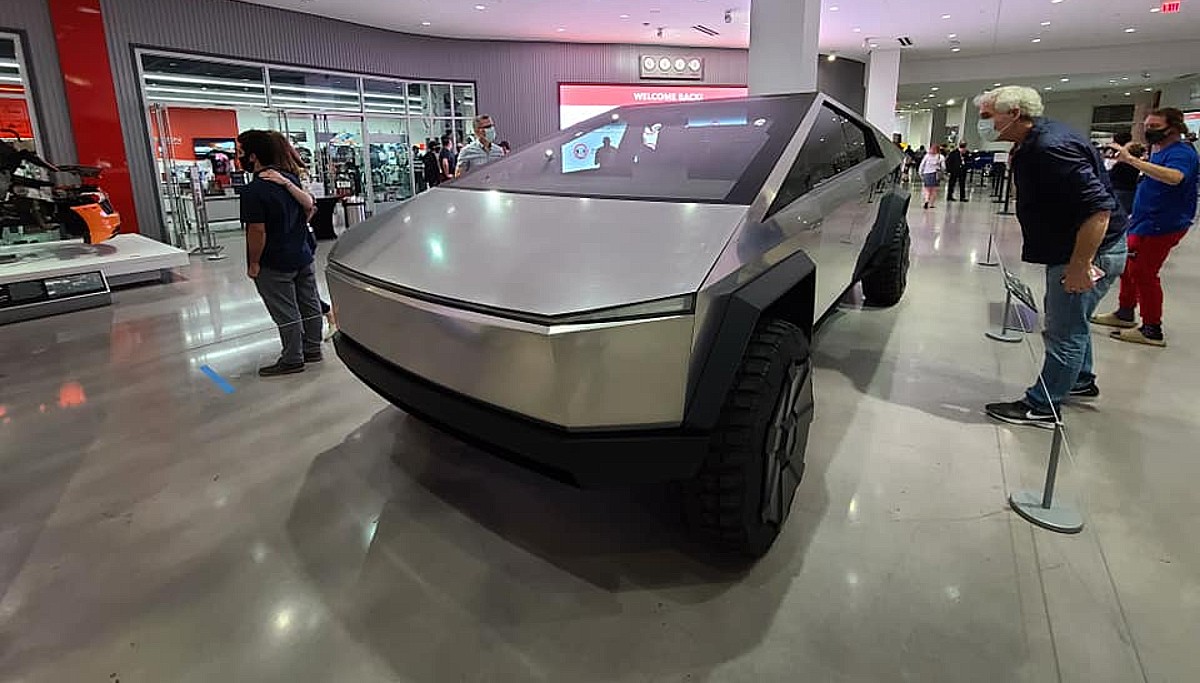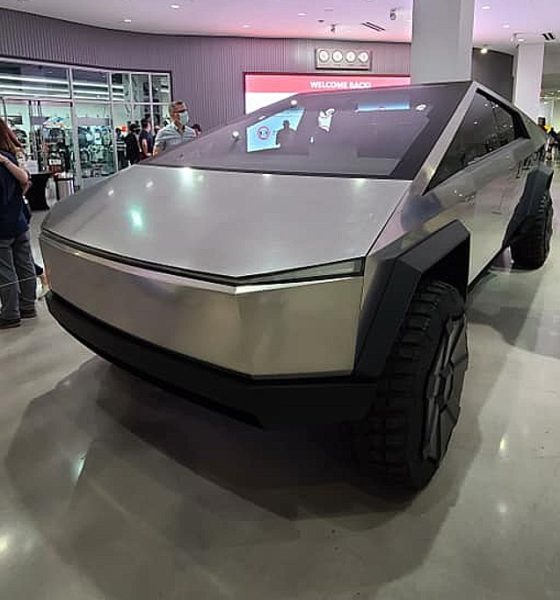

News
Ford’s battery problem with the F-150 Electric validates Tesla’s Roadrunner initiative
The battle for the all-electric pickup market is yet to begin, but one key player and a potential rival to the Tesla Cybertruck could be poised to experience some notable delays. Due to a legal dispute between LG Chem and SK Innovation, companies that are involved in the development and production of EV batteries, vehicles like the Ford F-150 Electric may end up having issues with their production ramp.
Last year, LG Chem filed a lawsuit against SK Innovation, a competitor in the electric vehicle battery market. The South Korean battery giant alleged that SK, a much smaller company, was stealing trade secrets. In its suit, LG Chem requested the courts to prevent SK Innovation from establishing a battery production facility in the United States. If LG Chem is successful, the lawsuit could result in disruptions to the battery supply for electric cars in the US, including the highly-anticipated Ford F-150 Electric.
Carmakers affected by the potential block to SK Innovation’s US expansion such as Ford and Volkswagen have campaigned with the International Trade Commissions (ITC) to allow the South Korean firm to go through with its planned US expansion, such as a battery manufacturing facility in Georgia. In a statement to Reuters, Volkswagen called on the ITC to let the South Korean firm make EV batteries in the US to “avoid a catastrophic disruption.”
LG Chem, for its part, has stated that it would step in and fill in the gaps that SK Innovation could leave in the US. Ford, however, notes that this proposal is not credible due to the short supply of base materials and development times of EVs. It should also be noted that LG Chem has shown some challenges in the past when it came to meeting the demand for its EV batteries, resulting in delays to electric cars like the Audi e-tron. Ford added that LG Chem’s initiatives could result in lost jobs for American workers as well. “The risk to such US jobs is especially unacceptable in light of current economic conditions caused by COVID-19,” Ford argued in a statement.
While it is unfortunate that projects like the Ford F-150 Electric are at risk of being delayed due to factors that are seemingly beyond the veteran carmaker’s control, the situation highlights the importance of a dedicated vertical integration initiative. Tesla, for example, is expected to announce its own pilot battery cell production system in the upcoming Battery Day event on September 22. Elon Musk, for his part, has proven to be very optimistic about the event, noting that Battery Day will likely blow everyone’s minds.
Such initiatives, such as Tesla’s “Roadrunner” facility in Fremont, are still in their pilot stage, but they could be a difference-maker in the long run. By developing its own battery cell production capabilities, Tesla and its vehicles like the Cybertruck will likely be able to weather most storms that could result from disputes between third-party battery suppliers like LG Chem and SK Innovation.
H/T @JPR007.

News
Tesla FSD fleet is nearing 7 billion total miles, including 2.5 billion city miles
As can be seen on Tesla’s official FSD webpage, vehicles equipped with the system have now navigated over 6.99 billion miles.

Tesla’s Full Self-Driving (Supervised) fleet is closing in on almost 7 billion total miles driven, as per data posted by the company on its official FSD webpage.
These figures hint at the massive scale of data fueling Tesla’s rapid FSD improvements, which have been quite notable as of late.
FSD mileage milestones
As can be seen on Tesla’s official FSD webpage, vehicles equipped with the system have now navigated over 6.99 billion miles. Tesla owner and avid FSD tester Whole Mars Catalog also shared a screenshot indicating that from the nearly 7 billion miles traveled by the FSD fleet, more than 2.5 billion miles were driven inside cities.
City miles are particularly valuable for complex urban scenarios like unprotected turns, pedestrian interactions, and traffic lights. This is also the difference-maker for FSD, as only complex solutions, such as Waymo’s self-driving taxis, operate similarly on inner-city streets. And even then, incidents such as the San Francisco blackouts have proven challenging for sensor-rich vehicles like Waymos.
Tesla’s data edge
Tesla has a number of advantages in the autonomous vehicle sector, one of which is the size of its fleet and the number of vehicles training FSD on real-world roads. Tesla’s nearly 7 billion FSD miles then allow the company to roll out updates that make its vehicles behave like they are being driven by experienced drivers, even if they are operating on their own.
So notable are Tesla’s improvements to FSD that NVIDIA Director of Robotics Jim Fan, after experiencing FSD v14, noted that the system is the first AI that passes what he described as a “Physical Turing Test.”
“Despite knowing exactly how robot learning works, I still find it magical watching the steering wheel turn by itself. First it feels surreal, next it becomes routine. Then, like the smartphone, taking it away actively hurts. This is how humanity gets rewired and glued to god-like technologies,” Fan wrote in a post on X.
News
Tesla starts showing how FSD will change lives in Europe
Local officials tested the system on narrow country roads and were impressed by FSD’s smooth, human-like driving, with some calling the service a game-changer for everyday life in areas that are far from urban centers.

Tesla has launched Europe’s first public shuttle service using Full Self-Driving (Supervised) in the rural Eifelkreis Bitburg-Prüm region of Germany, demonstrating how the technology can restore independence and mobility for people who struggle with limited transport options.
Local officials tested the system on narrow country roads and were impressed by FSD’s smooth, human-like driving, with some calling the service a game-changer for everyday life in areas that are far from urban centers.
Officials see real impact on rural residents
Arzfeld Mayor Johannes Kuhl and District Administrator Andreas Kruppert personally tested the Tesla shuttle service. This allowed them to see just how well FSD navigated winding lanes and rural roads confidently. Kruppert said, “Autonomous driving sounds like science fiction to many, but we simply see here that it works totally well in rural regions too.” Kuhl, for his part, also noted that FSD “feels like a very experienced driver.”
The pilot complements the area’s “Citizen Bus” program, which provides on-demand rides for elderly residents who can no longer drive themselves. Tesla Europe shared a video of a demonstration of the service, highlighting how FSD gives people their freedom back, even in places where public transport is not as prevalent.
What the Ministry for Economic Affairs and Transport says
Rhineland-Palatinate’s Minister Daniela Schmitt supported the project, praising the collaboration that made this “first of its kind in Europe” possible. As per the ministry, the rural rollout for the service shows FSD’s potential beyond major cities, and it delivers tangible benefits like grocery runs, doctor visits, and social connections for isolated residents.
“Reliable and flexible mobility is especially vital in rural areas. With the launch of a shuttle service using self-driving vehicles (FSD supervised) by Tesla in the Eifelkreis Bitburg-Prüm, an innovative pilot project is now getting underway that complements local community bus services. It is the first project of its kind in Europe.
“The result is a real gain for rural mobility: greater accessibility, more flexibility and tangible benefits for everyday life. A strong signal for innovation, cooperation and future-oriented mobility beyond urban centers,” the ministry wrote in a LinkedIn post.
News
Tesla China quietly posts Robotaxi-related job listing
Tesla China is currently seeking a Low Voltage Electrical Engineer to work on circuit board design for the company’s autonomous vehicles.

Tesla has posted a new job listing in Shanghai explicitly tied to its Robotaxi program, fueling speculation that the company is preparing to launch its dedicated autonomous ride-hailing service in China.
As noted in the listing, Tesla China is currently seeking a Low Voltage Electrical Engineer to work on circuit board design for the company’s autonomous vehicles.
Robotaxi-specific role
The listing, which was shared on social media platform X by industry watcher @tslaming, suggested that Tesla China is looking to fill the role urgently. The job listing itself specifically mentions that the person hired for the role will be working on the Low Voltage Hardware team, which would design the circuit boards that would serve as the nervous system of the Robotaxi.
Key tasks for the role, as indicated in the job listing, include collaboration with PCB layout, firmware, mechanical, program management, and validation teams, among other responsibilities. The role is based in Shanghai.
China Robotaxi launch
China represents a massive potential market for robotaxis, with its dense urban centers and supportive policies in select cities. Tesla has limited permission to roll out FSD in the country, though despite this, its vehicles have been hailed as among the best in the market when it comes to autonomous features. So far, at least, it appears that China supports Tesla’s FSD and Robotaxi rollout.
This was hinted at in November, when Tesla brought the Cybercab to the 8th China International Import Expo (CIIE) in Shanghai, marking the first time that the autonomous two-seater was brought to the Asia-Pacific region. The vehicle, despite not having a release date in China, received a significant amount of interest among the event’s attendees.








